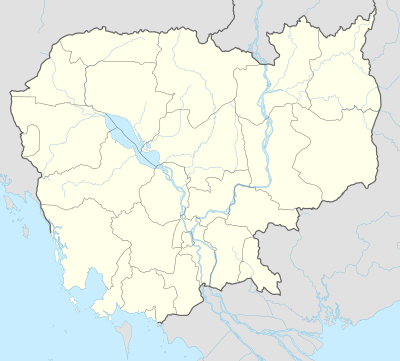East Mebon
The East Mebon(Khmer: ប្រាសាទមេបុណ្យខាងកើត) is a 10th Century temple at Angkor, Cambodia. Built during the reign of King Rajendravarman, it stands on what was an artificial island at the center of the now dry East Baray reservoir.[1]:73–75[2]:116
The East Mebon was dedicated to the Hindu god Shiva and honors the parents of the king. Its location reflects Khmer architects’ concern with orientation and cardinal directions. The temple was built on a north-south axis with Rajendravarman’s state temple, Pre Rup, located about 1,200 meters to the south just outside the baray. The East Mebon also lies on an east-west axis with the palace temple Phimeanakas, another creation of Rajendravarman’s reign, located about 6,800 meters due west.
Built in the general style of Pre Rup, the East Mebon was dedicated in 953 AD. It has two enclosing walls and three tiers. It includes the full array of durable Khmer construction materials: sandstone, brick, laterite and stucco. At the top is a central tower on a square platform, surrounded by four smaller towers at the platform’s corners. The towers are of brick; holes that formerly anchored stucco are visible.
The sculpture at the East Mebon is varied and exceptional, including two-meter-high free-standing stone elephants at corners of the first and second tiers. Religious scenes include the god Indra atop his three-headed elephant Airavata, and Shiva on his mount, the sacred bull Nandi. Carving on lintels is particularly elegant.
Visitors looking out from the upper level today are left to imagine the vast expanses of water that formerly surrounded the temple. Four landing stages at the base give reminder that the temple was once reached by boat.
Gallery
| Lintel showing Indra on Airavata |
| Elephant sculpture at the East Mebon |
| East Mebon guardian elephant |
| Lower terrace with elephant sculpture |
|
See also
References
- ↑ Higham, C., 2001, The Civilization of Angkor, London: Weidenfeld & Nicolson, ISBN 9781842125847
- ↑ Coedès, George (1968). Walter F. Vella, ed. The Indianized States of Southeast Asia. trans.Susan Brown Cowing. University of Hawaii Press. ISBN 978-0-8248-0368-1.
- Freeman, Michael and Jacques, Claude. Ancient Angkor. River Books, 1999. ISBN 0-8348-0426-3.
- Rooney, Dawn. Angkor. Airphoto International Ltd. 2002.
|
|---|
|
|
|
| |
|---|
| | Isan | | Khorat Plateau |
- Ban Anan
- Ban Bu
- Ban Chan
- Ban Chang Pi
- Ban Plai
- Ban Pluang
- Ban Samor
- Ban Sanom
- Chom Phra
- Don Tuan
- Huai Thap Than
- Khok Prasat
- Ku Ka Sing
- Ku San Tarat
- Ku Suan Tang
- Kuti Ruesi Ban Muang Khok
- Kuti Ruesi Ban Nong Bua Rai
- Muang Khaek
- Muang Tum
- Nang Ram
- Nong Plong
- Nong Ta Plaeng
- Phimai
- Pha Nom Wan
- Phnom Rung
- Phum Pon
- Pluei Noi
- Prang Goo
- Prang Phom ma Tat
- Ta Khwai
- Ta Leng
- Ta Muan
- Ta Muan Tod
- Ta Muen Thom
- Tra Piang Tia
- Ta Tom
- Thamor
- Sikhoraphum
- Wat Chao Chan
- Wat Dong Muang Tei
- Wat Kampang Lang
- Wat Prang Thong
- Wat Sa Kampaeng Noi
- Wat Sa Kampaeng Yai
- Yai Ngao
|
|---|
| | Sakonnakhon Plateau | |
|---|
|
|---|
| | Elsewhere | |
|---|
|
|
|
|
|
|
|---|
|
|
|
| Districts | | |
|---|
|
| Geography | |
|---|
|
| Angkor Sites | |
|---|

